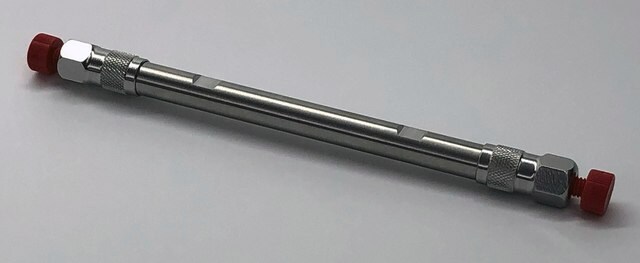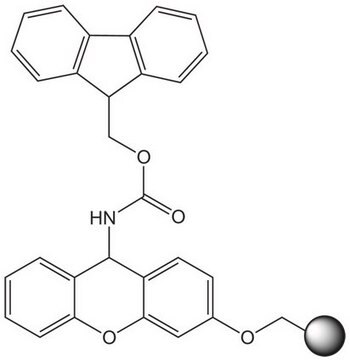567516-U
Discovery® HS F5 (5 µm) HPLC Columns
L × I.D. 15 cm × 4.6 mm, HPLC Column
Synonym(s):
Discovery Pentafluorophenyl PFP HPLC Column
About This Item
Recommended Products
product name
Discovery® HS F5 HPLC Column, 5 μm particle size, L × I.D. 15 cm × 4.6 mm
material
stainless steel column
Agency
suitable for USP L43
product line
Discovery®
feature
endcapped
manufacturer/tradename
Discovery®
packaging
1 ea of
extent of labeling
12% Carbon loading
parameter
≤70 °C temp. range
400 bar pressure (5801 psi)
technique(s)
HPLC: suitable
LC/MS: suitable
L × I.D.
15 cm × 4.6 mm
surface area
300 m2/g
surface coverage
4 μmol/m2
impurities
<10 ppm metals
matrix
silica gel, high purity, spherical particle platform
fully porous particle
matrix active group
PFP (pentafluorophenyl) phase
particle size
5 μm
pore size
120 Å
operating pH range
2-8
application(s)
food and beverages
separation technique
reversed phase
Looking for similar products? Visit Product Comparison Guide
General description
Generally, bases are retained longer on the HS F5 than on a C18. Increasing the organic content of a C18 separation 5 to 10 percent will generally provide similar retention on an HS F5. Results with other compounds are highly variable. However, it is generally true that solutes with log Po/w values less than 2.5 will be retained longer on HS F5 compared to a C18. The degree of difference is highly solute dependent.
Application
- Chromatographic separation of arsenic species with pentafluorophenyl column and application to rice.: This study leverages the Discovery® HS F5 HPLC Column for advanced arsenic speciation in rice, enhancing food safety analysis and ensuring compliance with health regulations (Baba et al., 2014).
- High-performance liquid chromatographic determination of tiapride and its phase I metabolite in blood plasma using tandem UV photodiode-array and fluorescence detection.: Demonstrates the versatility of the Discovery® HS F5 HPLC Column in the sensitive and simultaneous detection of tiapride and its metabolites, contributing to therapeutic drug monitoring and pharmacokinetic studies (Nobilis et al., 2011).
- Simultaneous quantification of nicotine and metabolites in rat brain by liquid chromatography-tandem mass spectrometry.: Utilizes the Discovery® HS F5 HPLC Column to accurately measure nicotine and its metabolites in rat brain, providing crucial data for studies on addiction and neuropharmacology (Vieira-Brock et al., 2011).
- Biomarker discovery in biological specimens (plasma, hair, liver and kidney) of diabetic mice based upon metabolite profiling using ultra-performance liquid chromatography with electrospray ionization time-of-flight mass spectrometry.: This research uses the Discovery® HS F5 HPLC Column to identify biomarkers in various biological samples from diabetic mice, enhancing our understanding of diabetes at the molecular level (Tsutsui et al., 2011).
- Practical analytical approach for the identification of biomarker candidates in prediabetic state based upon metabonomic study by ultraperformance liquid chromatography coupled to electrospray ionization time-of-flight mass spectrometry.: Employs the Discovery® HS F5 HPLC Column in a metabolomic approach to identify early biomarkers of diabetes, advancing preventive medicine and metabolic research (Tsutsui et al., 2010).
Features and Benefits
- Unique selectivity
- Similar retention to C18 (sometimes requires stronger mobile phase)
- Excellent peak shape
- Stable, low-bleed LC-MS separations
- Scalable separations from 3 to 10μm particle sizes
Legal Information
Application
analytical column
guard cartridge
Choose from one of the most recent versions:
Already Own This Product?
Find documentation for the products that you have recently purchased in the Document Library.
Protocols
Protocol for HPLC Analysis of Dopamine and Related Compounds on Discovery® HS
A protocol addressing HPLC Analysis of Acrylamide and Acrylic Acid on Discovery® HS F5
Chromatograms
application for HPLCapplication for SPE, application for HPLCapplication for SPE, application for HPLCapplication for HPLCOur team of scientists has experience in all areas of research including Life Science, Material Science, Chemical Synthesis, Chromatography, Analytical and many others.
Contact Technical Service







